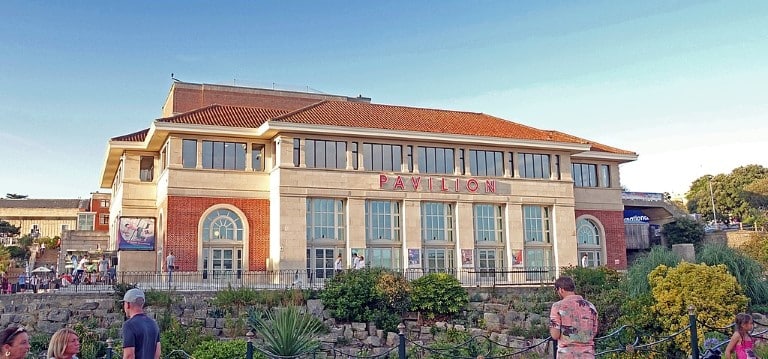Last Updated on 20/03/2023 by Alex Hamlyn
Table of Contents
Where is the tale of the Grey Lady from?
The Haunting of the Grey Lady
The Grey Lady of Bournemouth Pavilion is a legendary ghost associated with the Bournemouth Pavilion, a historic theatre and entertainment venue in the town. According to local folklore, the Grey Lady is believed to be the spectral manifestation of a former performer or stagehand who died at the Pavilion many years ago. Reports of sightings and supernatural activity in the theatre, particularly in the upper balcony, have been attributed to the ghostly presence of the Grey Lady.
The legend of the Grey Lady has been an enduring aspect of Bournemouth’s cultural and social identity for many years. As one of the most well-known ghost stories associated with the Pavilion, it has been the subject of numerous books, articles, and documentaries.
Despite the lack of empirical evidence, the legend of the Grey Lady continues to fascinate visitors and locals alike. The story adds to the mystique and allure of the Pavilion, contributing to the rich cultural history of the town. The legend of the Grey Lady is an example of the role of local folklore in shaping cultural identity, and the enduring power of ghost stories to capture the imagination of people across generations.
Who was the Grey Lady of Bournemouth Pavilion?
We also have limited records of deaths or accidents that occurred at Bournemouth Pavilion during the 19th century. The original Pavilion was destroyed by fire in 1896, but as far as we know, there were no fatalities in the fire. The current Pavilion was built in 1925, so any deaths or accidents associated with the venue would have occurred after this time.
However, we do have records of several serious incidents that occurred here during the 20th century.
29 February 1984: Fire
The incident that occurred at the Bournemouth Pavilion in 1984 was a serious fire that caused extensive damage to the theatre. The fire broke out in the early morning hours of February 29th, 1984, and quickly spread through the building, causing significant damage to the roof, the upper balcony, and the stage area.
The cause of the fire was determined to be an electrical fault in the stage lighting system. Fortunately, the theatre was closed at the time of the fire, so there were no members of the public in the building. Although several firefighters were injured while battling the blaze there were no reported deaths.
The fire caused significant damage to the Pavilion, and the theatre was closed for a period of time while repairs and renovations were carried out. The restoration work included the installation of new lighting and electrical systems, as well as the repair and replacement of damaged walls, ceilings, and other structures.
The Pavilion was able to reopen in December of 1984, just nine months after the fire, and has since continued to be one of the most popular entertainment venues in Bournemouth. The theatre’s management and staff were praised for their quick and effective response to the fire and for their efforts in restoring the building to its former glory.
The 1984 fire at the Bournemouth Pavilion was a stark reminder of the importance of fire safety and the need for regular maintenance and inspections of public buildings. The Pavilion’s response to the fire demonstrated the resilience and determination of the theatre’s staff and management, and their commitment to providing a safe and enjoyable environment for their patrons.
15 May 1959: Falling Chandelier
Another serious incident occurred on May 15th, 1959, during a performance of the musical “The King and I”. According to reports from the time, the chandelier, which was suspended from the ceiling by a wire, suddenly came loose and plummeted down onto the audience in the stalls below.
Several people were injured in the incident, including a 14-year-old girl who suffered head injuries and a broken arm. The injured were taken to a nearby hospital for treatment, and the show was immediately halted. However, no deaths were reported so it is unlikely this girl became the Grey Lady of legend.
An investigation was launched into the cause of the accident, with a focus on the safety of the theatre’s equipment and fixtures. In the aftermath of the incident, the theatre undertook a series of safety upgrades, including more rigorous safety inspections and improvements to the theatre’s lighting and electrical systems.
The 1959 incident was a tragic reminder of the importance of safety in public spaces and the need for regular maintenance and safety checks. However, the Pavilion took swift action to address the issues that led to the accident and has since maintained a strong record of safety and performance.
1930s: Emily the Actress
Another tale that pops up is that of an actress named Emily who apparently died on stage in the 1930s. Unlike the other stories linked to accidents and deaths, we have little documented evidence of this beyond eyewitness accounts.
Stories over the years include the sound of footsteps from an empty stage, poltergeist activity, and one member of staff claimed to have been chased. Another story from a visiting Clairvoyant describes a woman in period costume who matches other descriptions provided.
(And we can’t help wondering how helpful the description of the period costume really is. If it really is an actress haunting the Pavilion, who is to say she is not simply dressing up for the occasion? After all, ghosts are sometimes known to be mischievous things.)
Although there is little empirical evidence to support the existence of ghosts or paranormal phenomena, some would say the story of the Grey Lady is likely based on local folklore and imagination.
However, the story of Esme Blackwell seems to fit the facts better than any others.
23 September 1938: Esme Blackwell dies
Finally, we come to our only real contender.
The incident that occurred at the Bournemouth Pavilion in 1938 was a tragic accident that resulted in the death of a young girl. The girl, named Esme Blackwell, was just 16 years old at the time. The incident was widely reported at the time and remains a tragic event in the history of the Pavilion.
The incident occurred during a performance of the play “The Life and Adventures of Nicholas Nickleby” on the evening of September 23rd, 1938. Esme was sitting in the balcony of the theatre, which was reportedly overcrowded at the time, when she leaned over the rail to get a better view of the stage. She lost her balance and fell over the rail, plunging to the ground below.
Esme was rushed to a nearby hospital, but sadly, she died from her injuries the following day. Her death was a tragedy for her family and friends, and it had a profound impact on the local community.
In the aftermath of the incident, there was much debate and discussion about the safety of public buildings, including theatres and other entertainment venues. The incident at the Bournemouth Pavilion prompted calls for stricter safety regulations and better safety equipment in public spaces.
Although there is little empirical evidence to support the existence of ghosts or paranormal phenomena, some would say the story of the Grey Lady is likely based on local folklore and imagination.
However, the story of Esme Blackwell seems to fit several facts.

Is Esme Blackwell the Grey Lady of Bournemouth Pavilion?
As the story goes, the Grey Lady is a figure which haunts the upper balcony of the Pavilion. While these stories tend to report the figure as a ghost of a performer or stagehand, we have no records of any deaths that took place in the Pavilion. Would you go back to haunt your place of work if you died elsewhere?
The sad story of Esme Blackwell is a better fit. Esme was sitting in the balcony and tragically fell to her death during a performance. There was no teenage culture in 1938, so 16-year old Esme would have been considered a ‘lady’ more than a child. Her accident also meant she never saw the end of the play, and lack of closure is a common thread in many ghost stories.
Of course, we can’t be sure, but the evidence we have certainly appears to fit the sad legend of this reported haunting.
Image credits
- Bournemouth Pavilion: Tiia Monto, CC BY-SA 3.0 https://creativecommons.org/licenses/by-sa/3.0, via Wikimedia Commons
References
- https://www.waymarking.com/waymarks/wm4QT1_Emily_Pavilion_Theatre_Bournemouth_Dorset_UK
- https://www.paranormaldatabase.com/hotspots/bournemouth.php
- https://www.dorset.live/news/dorset-news/ghostly-tales-bournemouths-dark-past-7750584


